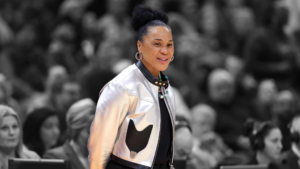Dawn Staley Just Taught a Powerful Lesson on Leadership
Originally published by Michelle Silverthorn for Inc.
On April 7, 2024, Dawn Staley and her South Carolina Gamecocks women’s basketball team won the NCAA women’s championship. At the end of the game, ESPN reporter Holly Rowe interviewed Coach Staley to ask her how she felt. Coach Staley couldn’t respond for a few moments because she was so overwhelmed by the moment. In her tears, you saw the immense pressure she had been under and her immense expectations of herself — another national championship, an undefeated season, redemption from last year’s shocking upset, and the departure of all her starters. In her tears, Coach Staley showcased her vulnerability and in doing so, demonstrated my number-one lesson for authentic leaders–vulnerability shows your courage.
It is never easy for leaders to be vulnerable. But the payoff is extraordinary. The ability to feel seen. To share your truths with your world. And, in turn, to be seen as a leader who exemplifies both strength and humility. When we accept and commit to sharing our emotions as leaders, we open doors to creating healthy workspaces that foster team growth and promote trust.
However, there is the flip side. A public that is quick to judge and slow to forget. See, when we fear facing backlash, it can be difficult to express our authenticity. Defensiveness, minimizing, and biases lead us to keep our emotions to ourselves. We know the stereotypes of who cries at work. Or who shouldn’t cry at work. Or who gets angry in public. Those stereotypes often leave many of us without the runway to be vulnerable.
So what are a few ways we can safely express emotional vulnerability as a leader? Here are my three pieces of advice.
1. Use ‘I’ statements
When we use “I” statements, especially when we make or oversee mistakes, it allows us to focus on our feelings and experiences and can minimize others’ defensiveness and the feeling of being blamed. You can then share the accountability–and the recovery.
2. Lead the Change
We all want workplaces where we feel understood and like we belong. So the work falls on us all to make those changes. Are you a leader who allows for honesty from your team? Do you encourage them to share their struggles? Do you share what you are struggling with? Do you welcome their feedback or do you shut that down? Do you create a healthy environment for people to feel like they can succeed?
3. Find your support
When I do my thriving at work keynotes, I ask people to think about their retirement speeches. You know what they say? “I loved being here.” “I loved doing this work.” “I loved the people I worked with.” To paraphrase actress Danai Gurira, “Go where you are loved and you will do your best work.” You as a leader are going to build inclusive teams, but you also need to lean on one for yourself. Find a healthy, supportive leadership community at work that values your authentic contributions and validates you. In turn, you deliver your best work to them.
Expressing our emotional vulnerability is a sign of strength and courage. Most of all, it’s a sign of good leadership. That’s how we create safer, more authentic workplaces where we can all thrive, belong, and succeed.
Congratulations to Dawn Staley and the South Carolina women’s basketball team. What a leader, what a legend, and what a legacy to leave behind.
